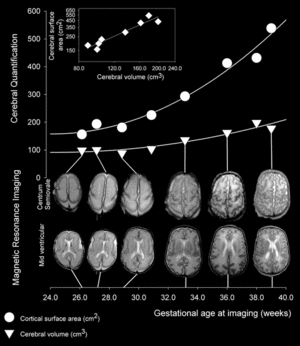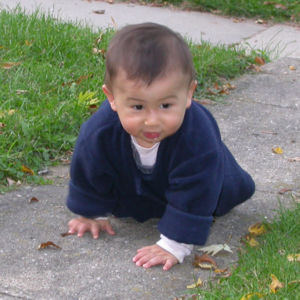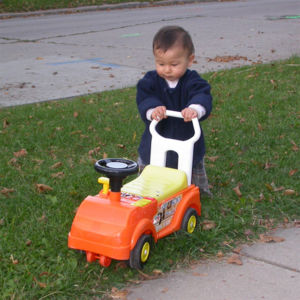Infant growth and development
Growth and development are the main themes of every baby's life; the physical and mental activities that parents call,"growing up". Since this process has everything to do with health at the juvenile stages of human life, it is a fundamental topic in pediatrics. The normal growth and development of infants has a known course and range of values for most of the characteristics that have been considered important enough to measure. These include height and weight and other physical measurements, as well the ages that behaviors, like sitting up and walking, are normally demonstrated.
There are very short periods during any stage when a youngster is mainly just getting bigger; but infancy, childhood and adolescence are never focused on a mere increase in size. Instead, growing-up alters the shape, composition, and abilities of body and mind. In the first era of life the newborn baby changes, in a certain sense, transforms- into an entirely different creature: the toddler. No one word in English encompasses that concept, and in life sciences, "growth and development" is the conventional term for these serial changes that occur from birth to maturity.
Through them, a newborn becomes a toddler -and then a child, and continued growth and development in childhood and through puberty, usher her into adulthood. There are two stages in human life when growth and development are most rapid; (1) one is in infancy and very early childhood, and (2) the other is during puberty and adolescence. This article examines the early part of the first of these periods, covering the normal progress of a newborn up to the time of walking; generally, about the first year to 18 months of life. (The next stage of life is discussed in Toddler growth and development, which will cover the normal child from the time of walking to the socialization of the preschool era; from about age 1 year to age 4 years.)
Overview : the newborn's head and brain are small
Oddly enough, there is an inherent connection between the very immature state of the newborn brain, a fundamental feature at the starting point of infancy; and the very human act of walking upright, the end point of our discussion here, and the one that marks the beginning of a child's "toddler stage". Human beings, as a species, have a large brain that is capable of a high intelligence, and an upright body position that is propelled by walking on two legs. Walking upright allows for less leeway in size and structure in the human pelvis than exists for those animals that walk on all fours. That means that big-headed babies are born to mothers with relatively constrained birth canals. If both mother and baby are to survive the birth process unscathed, the baby's brain cannot be fully developed in size or complexity at birth. No matter how precocious we may fancy that our children are, no human baby is precocious as a horse's newborn foal or a duckling just out of the egg. Unlike those new babies, that can run and swim when only hours old, humans are unable to do much more than feed and interact with their caregivers until several months of life have passed.
Our newborns have a skull that contains a brain case only one quarter the size that it will become in the adult. "The brain comprises 100 billion neurons at birth, with each neuron developing on average 15,000 synapses by 3 yr of age." (reference for quote: Robert D. Needlman: Part 2 – Growth and Development. Chapter 7 – Overview and Assessment of Variability in Behrman: Nelson Textbook of Pediatrics, 17th ed., Copyright © 2004 ISBN 978-1416040040) Much of the growth of the brain; and the concommittent expansion of the head; has occurred by the age of 2 years; at that age the neurocranium (which means the bony skull that surrounds the brain) is 75% of the adult size by volume, and the brain is about 80% of its adult weight. By about 10 years of age, the brain (and skull) are aproximately 95% their ultimate size. Overall, the human brain more than triples in size (3.5 X) from birth to adulthood.
Even with the relatively small head diameter of the newborn, that skull has some adaptations that allow it to be molded in the birth canal, so that the diameter can become even smaller, allowing the baby to emerge without harm to itself or to its mother. These same adaptations give the baby's skull the ability to expand to accomodate the growing brain - they are the suture lines and fontanelles of the infant skull. The suture lines allow the bony plates of the skull to slide a bit, and provide an extra dimension of flexibility for the emergence of the baby's head without damage to the brain. The fontanelles are areas that XXXX.
When babies are brought to the pediatrician or other health care provider for well-child care, the infant's length, weight, and head circumference are routinely measured. The "soft spots" of the skull, the fontanelles, are gently touched and assured to be either properly open or closing, and not unduly tense. The baby is also checked for reflexes and activities that are the signs of normal physical and mental progress. Although the rate of change is a bit different for each individual child, the changes follow a set of curves that are so similar for all children that deviations from the expected values are signs that trouble may be afoot. Since youngsters are so adaptable, and so many problems are now amenable to treatment with early intervention and proper medical care, many things that would have once proved devastating to the baby's future can be averted or minimized with careful monitoring of our infants progress and judicious evaluation of possible abnormalities.
This article reviews the important milestones, and their timing, that unfold during an infant's life. Strictly, the term "infant" only applies to baby during the first year, but since such activities as walking can normally occur either during the first year or after, a broader range of ages is considered here.
Newborns
A newborn baby's normal range of perception and activity is different than it will be later in life. Newborns are nearsighted, with a fixed focal length of 8–12 in, which is approximately the distance from the breast to the mother's face. (reference: Hearing is Behavioral testing of newborns has established that as well as an inborn visual preference for faces.
Just after birth, most babies are alert and able to participate in social interaction. "The initial period of social interaction, usually lasting about 40 min, is followed by a period of somnolence. After that, briefer periods of alertness or excitation alternate with sleep. If a mother misses her baby's first alert-awake period (because she has been anesthetized), she may not experience as long a period of social interaction for several days." (reference for quote:Chapter 9 – The Newborn inBehrman: Nelson Textbook of Pediatrics, 17th ed.Copyright © 2004 Saunders, An Imprint of Elsevier )
Whereas older babies and adults normally have air in their middle ears, for example, just after birth babies normally have some fluid which will dissipate over time. Hearing in babies is present at near normal adult levels, but measuring that hearing is not straightforward.
The metabolism of a newborn baby is much higher than an adults', and the baby's body dissipates the heat generated by metabolic processes very efficently, since there is so much surface area as compared to mass.
Transitional changes: adapting to the new world
Every normal newborn baby has just exchanged an internal environment within her mother's body for the the external world. That statement is obvious, but its ramifications are quite profound. temperature for one of air where the temperature fluctuates much more dramatically and often, and every baby has just changed its means for respiration and nutrition from being esentially another organ in his mother's body to being an independant entity who must breathe through his own airway and oxygenate his blood with lungs, and obtain his own nutrients from nursing and digesting his mother's milk or formula through his digestive system.
THE NEWBORN INFANT - Richard D. Bland RUDOLPH'S PEDIATRICS - 21st Ed. (2003)
Every newly born infant is not a "normal full-term infant": exceptions
The characteristics of newborns that have been discussed so far are not true for every newly born baby, but instead describe the general group of so-called normal, healthy, full-term infants. At birth, many babies fall outside these limits. When infants are born prematurely, they may or may not be healthy, but their abilities and characteristics are not the same as infants born after the full development in the uterus that occurs when pregnancy lasts an optimal period of time. Their usual characteristics can be pretty well predicted according to just how long they did develop- which is their gestational age. In other words, the extent of their prematurity, usually measured in weeks, is of cardinal importance in describing the premature infant. Like premature infants, infants who have been "in too long", and are born postmature, have features and characteristics that are predictable depending on the length of intrauterine development. Additionally, there are infants who had a normal length of time in the womb, but are so far above or below the usual size of a full-term infant that they are sometimes described separately. Although these infants may grow up to be normal adults, the extra-small infants who are "small for gestational age", and the extra-large infants who are much larger than average, each, within their groups, share some features. All of these groups of newborn are discussed in the following sectiions.
Premature newborns

When babies are born prematurely, they have left the intrauterine environment "too soon". In a sense, there are different dimensions of "too soon", ranging from what appear to be insignificant lengths of time, in which the baby has achieved all the characteristics that are associated, objectively, with a full term infant, all the way to so early that the baby, even with maximal life-support technology, cannot survive. The limits for how early a baby can be born, and the odds that a premature baby at any given stage can survive outside the womb have changed, and are changing, with advances in medicine and technology. At any given stage, the indovidual characteristics of the infant also influence survival.
Some of the features that are typical at varying gestational ages are summarized below: (Please note that these features are included for educational purposes, and not because they specifically "make" a diagnosis of a particular gestational age.)
23 weeks:
25 weeks:
27 weeks:
29 weeks: "The pupils are normally relatively dilated until 29 weeks of gestation, at which time the pupillary light response first becomes apparent." (reference for quote:
Douglas R. Fredrick, MD:Chapter 17. Special Subjects of Pediatric Interest in Paul Riordan-Eva and John P. Whitcher (Eds) Vaughan & Asbury's General Ophthalmology
16th Edition, Copyright © 2004 by The McGraw-Hill Companies, Inc.)
The concept of "gestational age adjustments"
Gestational age is the amount of time that the baby has developed in the womb, and when full-term, this is a total of about 37 weeks from conception to birth. Obstetrical conventions for the calculation of the gestational age is slightly different, it has to do with the date of the last menstrual period, and therefore, since ovulation in a 28 day cycle is likely to have occurred 2 weeks later, would add 2 weeks to the estimated time of conception.
"Infants who are born after completing less than 37 completed weeks of gestation are considered to be preterm (or premature). Term infants have completed 37 to 42 weeks, and infants past 42 weeks of gestation are postterm (or postmature)." 2.8 EXAMINATION OF THE NEWBORN INFANT - Andrew R. Wilkinson, Valerie E. Charlton, Roderic H. Phibbs, Claudine Amiel-Tison Rudolf's Pediatrics
If a baby is born prematurely, say at 33 weeks instead of 37, then the baby's age after birth is adjusted, in the minds of physicians, nurses, and other allied health science caregivers, to reflect that prematurity. The baby born at 33 weeks has an adjusted age of 11 months on his first birthday, at least in terms of of his expected development.
Just how precisely can we judge the gestational age of any newborn? Unless the birth mother had used some accurate means to calculate ovulation at the time of conception, or has had such extremely regular menstrual periods that conception can reliably be assumed to have occured about 14 days before the first missed period, or, for some reason, has had a series of ultrasounds during prenatal care, before about 20 weeks, the time in the uterus from conception to the birth of the infant is always an estimated one.
"Small for gestational age" newborns
Not every small baby is a premature baby.
"Large for gestational age" newborns
When the fetus gets enriched nutrition in the womb, the baby may be born "extra-large". Mothers who have high blood glucose (diabetes) during the last trimesters of pregnancy are more likely to have such babies. The size of a newborn is more closely related to the efficiency of the placenta and the nutrients available in the mother's bloodstream, than to the size of the mother and father.
Physical size and growth
Height (length), weight (body mass), and head circumference
Babies are measured after birth because this information provides immediate means for evaluating the infant, but most importantly because the measurements serve as a baseline to follow future growth. Length is measured from the tip of the newborns skull (vertex) to her heels, with legs fully stretched out in an extended position. Weight is measured when the baby is wiped off and the umbilical cord has been cut. The head circumference is measured around the head from back to front, above the ears.
There is a range that descibes these values in newborns of both genders and a pattern of the increase in these values over the months and years that has been compiled from the records of infants and children. These values are useful when they are expressed in percentiles and an individual child's progress in charted and compared to the known growth curves.
Except for the first week or so after birth, babies normally increase in weight rather than decrease. "During the first week after delivery, infants born at term tend to lose about 5% of their birth weight." Although this amount of weight loss is not only normal, but is expected in full-term infants, premature infants actually lose more weight in those first days. "The youngest of premature infants may lose 15 to 20% of their birth weight with no apparent ill effects."(reference:nb infant Rudolph's Pediatrics - 21st Ed. (2003))
As babies get older, otherwise, they normally grow, and changes in weight and length are always increases and never decreases. Although transient weight loss might occur with illness or an inadequate diet, it is never "normal" once those first weeks are passed. In fact, not only is weight loss abnormal- but an absence of weight gain is of potential concern. An infant whose weight and height are stable rather than increasing is said to have "failure to thrive". There are many reasons that can account for this failure to grow, and many are temporary and treatable.
Growth and nutrition
Diet plays an important role in growth during infancy. Not only are certain components, like adequate proteins and vitamins crucial for normal growth, but an adequate number of calories must be consumed over and above that required for metabolic activities for growth to occur.
Breastfeeding is the preferred feeding for infants,unless maternal infection with an illness transmissable in breast milk is present. However, infant formulas can support growth at rates equal to breast milk feeding and without any apparent deficits resulting in infants.
Growth rates and the incidence of certain medical conditions in adulthood
There have been recent studies in countries with highly developed health systems and excellent record keeping that have revealed statistically significant correlates between some of the early growth values and medical conditions in later life. For example, numerous studies have shown an association between having low percentile values for age adjusted weight from birth to age 1 year and an increased risk of stroke and heart attack in adulthood. The researchers have concluded that this statistical correlation has to do with maternal physique and inherited factors.(Rich-Edwards JW, Stampfer MJ, Manson JE, Rosner B, Hankinson SE, Colditz GA, Willett WC, Hennekens CH. Birth weight and risk of cardiovascular disease in a cohort of women followed up since 1976. BMJ. 1997;315:396–400., Martyn CN, Barker DJP, Osmond C. Mothers' pelvic size, fetal growth, and death from stroke and coronary heart disease in men in the UK. Lancet. 1996;348:1264–1268,Lawlor DA, Ronalds G, Clark H, Smith GD, Leon DA. Birth weight is inversely associated with incident coronary heart disease and stroke among individuals born in the 1950s: findings from the Aberdeen Children of the 1950s prospective cohort study. Circulation. 2005;112:1414–1418.,Osmond C. Kajantie E. Forsen TJ. Eriksson JG. Barker DJ. Infant growth and stroke in adult life: the Helsinki birth cohort study. Stroke. 38(2):264-70, 2007 Feb. UI: 17218608)
The face
Baby faces are different than adult faces, and for good reason. The newborn's forehead is relatively enormous, with the eyes more or less centered mid-height of the face. In an adult, the eyes are about a third of the way down from the top of the face, with the forehead, the midface, and the lower face each making up about a third of the total height.
Teeth, ears and sinuses
Neurologic development
Just as the physical development of an infant during the first year or so or life is a vector in which the values of height, weight, and head circumference always increase, there is a normal series of behavioral milestones that can be arrayed in a timeline over this period, and the individual infant's passing of these miletones is always in a forward direction. The absolute age at which a child may first demonstrate one of these behaviors, such as, say, sitting up, or walking, is variable and is perfectly normal within a relatively broad range. It is never normal, however, for a baby to be able to sit up and then to lose that ability, or to be able to walk well and then not be able to walk at all, or to become less adept at walking.
Milestones
From Capute AJ, Biehl RF: Pediatr Clin North Am 1973;20:3; Capute AJ, Accardo PJ: Clin Pediatr 1978;17:847; and Capute AJ, et al: Am J Dis Child 1986;140:694. Rounded norms from Capute AJ, et al: Dev Med Child Neurol 1986;28:762. Harriet Lane Handbook
smiling
head & torso control
By about 1 month of age, a baby can lift his head when lying prone. Strength and control normally increase so that, by 2 months of age, she can manage to lift her chest up as well, when lying in this same prone position - and keep her head in the midline. At 3 months, he is expected to be able to support himself with his forearms, holding his chest up off the floor or table, and keeping his head held steadily in the midline.
rolling over
Rolling over is expected by 4 months of age. Since some babies do it sooner, even much sooner, it's important to keep the baby safe when laying her down on a surface she might roll off of and not allow her first success at rolling over to cause injury.
sitting up
By six months, a baby should be able to sit unsupported.
grasp (thumb and fingers)
The pincer grasp is not only an important developmental milestone, it has important consequences for the child's safety.
crawling
standing up
walking
Changes in the body that come from activities
Body parts are not static structures, they change depending on how they are used. Weight bearing and mechanical forces thicken bone, and so muscles and bone change together as they grow. For example, the mastoid process, which is the thick bump that can be felt behind any adult's ear (down around the region of the upper earlobe), does not exist in the newborn baby, instead the baby's skull is flat behind the ear. A muscle in the neck, the sternocleidomastoid muscle, runs, in part, from this spot on the skull, down to the collar bone and the top of the sternum. As the muscle contracts with the greater force as the baby grows and develops the ability to raise his head and hold it up, the bone actually thickens and the mastoid process developes. Other changes in the body occur with standing and walking. The spine developes what is called "lordosis", the straight backed baby has a different back contour than the walking toddler. The bottom of the feet in the baby who does not stand are "rocker-bottom" shape, and change as the child puts weight on those feet and change still more with walking. In those disabled children who never walk , the feet retain their infant contour.
the back
the feet
Becoming a toddler
When a child can first maneuver through the world on her own two feet she is called a toddler. By that stage of development, which generally begins between about 9 and 18 months of age, locomotion is allows wider exploration of the world. There are reasons ranging from otitis media to orthopedic issues to neurological problems that can delay the age of walking, but this stage of childhood is marked by additional attainments outside of walking.


